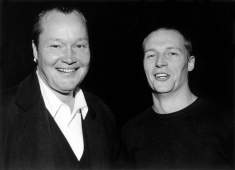
Nils Landgren & Esbjörn Svensson Duo
Švédsko
Každá hudba má své kořeny ve folklóru. V některých hudebních stylech je to
snadno rozpoznatelné. V jiných se během staletí kulturního vývoje tyto kořeny
vytratily. Zbavíme-li je však ornamentace a artistní strukturovanosti, základ
zůstane týž. Melodie a struktury, které působí na lidi v každodenním životě,
uchovávají jádro hudebních znalostí a zkušeností. Jsou východiskem kolektivního
vědomí a výzvou pro tvůrčí činnost. Individuálnost spolu s novátorstvím
kontrastuje svou nekonvenční prací s těmito folklórními tvary. Tak je to
s tajemstvím umění, které balancuje mezi pamětí a fantazií, mezi folklórem,
tradicí a improvizací.
Nils Landgren se narodil v roce 1956 a vyrůstal s hudbou svého otce,
jazzového hráče na kornet, a chrámovou hudbou dědečka, který byl pastorem. Nikdy
neztratil silnou vazbu k tomuto hudebnímu dědictví.
Esbjörn Svensson, narozený v roce 1964, nechtěl zpočátku lidovou hudbu
hrát. Měl rád Chopina, Ellingtona a skupiny jako The Sweet. Tento pianista našel
své místo nejprve na silně konkurenční švédské hudební scéně. Jeho trio bylo
úspěšné a ve své vlasti byl zvolen hudebníkem roku v letech 1995 a 1996. Stal se
vyhledávaným hudebníkem. Osvědčil se v kapelách svého přítele Nilse Landgrena.
Hrál funk a soul, příležitostně pop, a především klasický jazz. Ne však folklór.
Pod vlivem Landgrena a Svenssonova učitele Bengta Arne Wallina, který nahrál
důležité album v roce 1962 ("Old Folklore in Swedish Modern"), Svensson
a Landgren nahráli v duu album, vycházející z lidových písní. Je na něm jen
trombón s klavírem a bylo vydáno roce 1997 (Swedish Folk Modern ACT 9257).
Zajímavé propojení tradičních lidových písní s improvizacemi zapůsobilo
na posluchače a získalo cenu kritiky. Svensson s Landgrenem stvořili více než
pouhé duové improvizace. Svým způsobem pokračovali v tom, co začali v šedesátých
letech Jan Johansson a Bengt-Arne Wallin, a co se stalo hlavní hnací silou
evropského jazzu.
Po vydání Swedish Folk Modern nastal pro oba hudebníky čas hektické aktivity.
Nils Landgren's Unit se dostal do pozice obdivovaných festivalových hvězd.
Svenssonovo vlastní trio EST hrálo často také za hranicemi Skandinávie. Přesto
si našli Landgren se Svenssonem v roce 1999 čas na společný projekt v Oslo's
Rainbow Studio. Bylo to setkání plné výjimečné jazzové energie. Více než poprvé
spoléhali na sílu redukce. V hudbě dua je sugestivní atmosféra, melodie
vystupují s neporušenou čistotou. Delikátní variace znásobují a rozsvěcují
originální i tradiční motivy. Toto album s názvem "Layers of Light" je odrazem
cítění dvou umělců, kteří se vracejí ke svým kořenům. Je to hudba pravdivá,
přímá a autentická.
Nils Landgren & Esbjörn Svensson Duo
Sweden
All music has its roots in folklor. In some playing styles this is easy to
recognize. In others hundreds of years of cultural development and change have
effectively sublimated those roots. Strippen of ornamentation and structural
artifice, however, the foundation remains the same. The melodies and structures
that affect and influence people in their day to day lives remain the basis of
musical knowledge spirit. Individuality along with innovation in its surprising,
unconventional workings emerge as a contrast to those folk origins. So is the
secret art by which the balance between mnemory and fantasy, betweet folklore,
tradition, and improvisation is weighed.
Nils Landgren was born in 1956 and grew up with the music of his father, a
jazz cornetist, and the church music of his grandfather, a pastor. He never lost
his strong affinity for his own musical heritage.
Esbjörn Svensson, born in 1964, didn't want to play folk music at first. At
home with the music of Chopin, Ellington, or disco-pop groups such as The Sweet,
the pianist had first found his place in the competitive music scene in Sweden.
His trio was a success, and in his homeland he was voted jazz musician of the
year in 1995 and 1996. The first sprinkling of jobs became a steady flow.
Swensson proved himself in the bands of his friend Nils Landgren. The music was
about funk and soul, occasionally pop, and in the main, classic jazz. But not
folklore.
It was through the influence of Landgren and Svensson's former teacher
Bengt-Arne Wallin, who recorded the landmark album "Old Folklore In Swedish
Modern" back in 1962 (ACT 9254), that Swensson and Landgren were inspired to
make a duo album centered around folk songs. In August 1997 both went into the
studio and with only trombone and piano recorded Swedish Folk Modern (ACT 9257).
Their improvised treatments of the classic songs of the folk culture not only
impressed the public, it brought praise from the press. Svensson and Landgren
had created more than just a few impressions in duo. Discording any sort of
large conceptual superstructure, they had continued what Jan Johansson's Jazz pa
Svenska and Bengt-Arne Wallin had begun in the early sixties and what has since
become a major force within the inner workings of European jazz.
The time after Swedish Folk Modern was hectic and exciting. Nils Landgren's Funk
Unit advanced to the position of a celebrated festival act. Svensson's own trio,
EST expanded beyond Scandinavia's borders, where the band's fortunes
skyrocketed. Inundated with jobs, the musicians finally found the time to once
again get together in December 1999 in Oslo's Rainbow Studio. It would be a
meeting full of exceptional jazz energy. Even more than the first time, they
would rely on the force of reduction. Moods would be suggested, left open.
Melodies worked out in simple clarity. Delicate variations supplemented and
amplifield both the original and traditional motifs of the central musical
impressions. Layers of Light is an affair of the hearts of two artists who went
back to their roots. That makes their nusic truthful, direct, and authentic in a
wondrous way.
